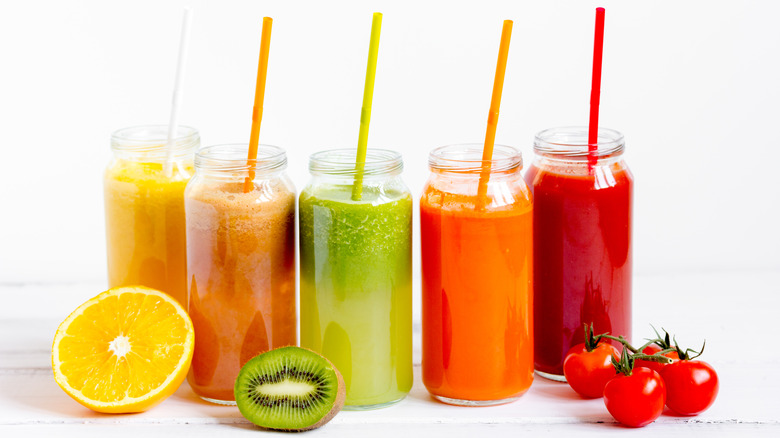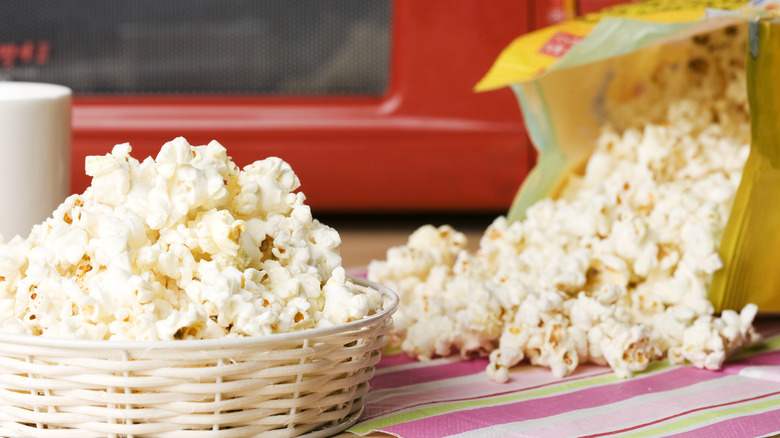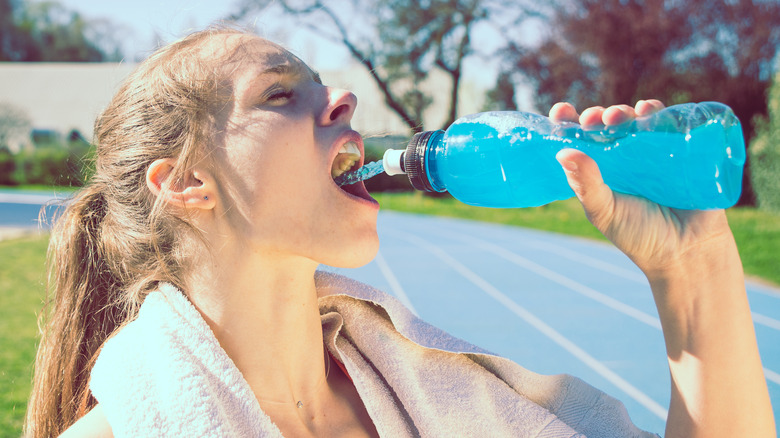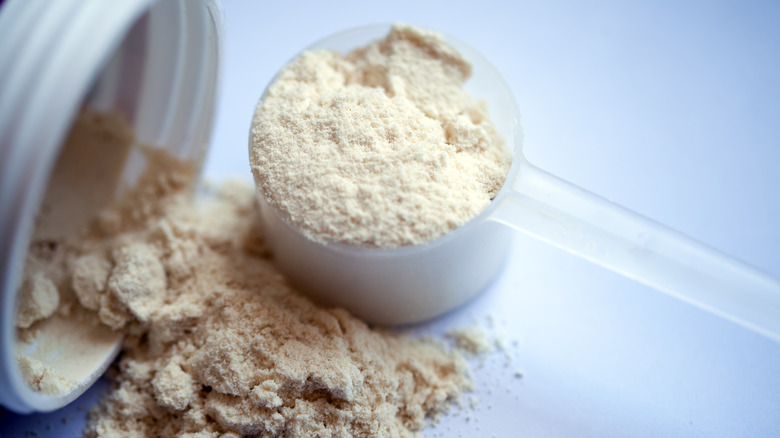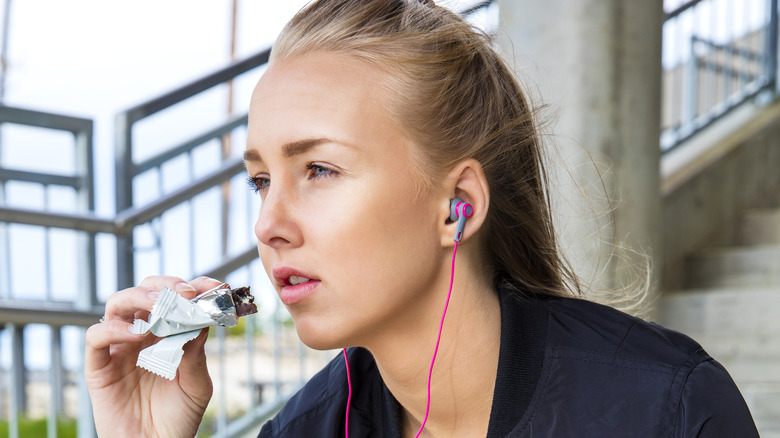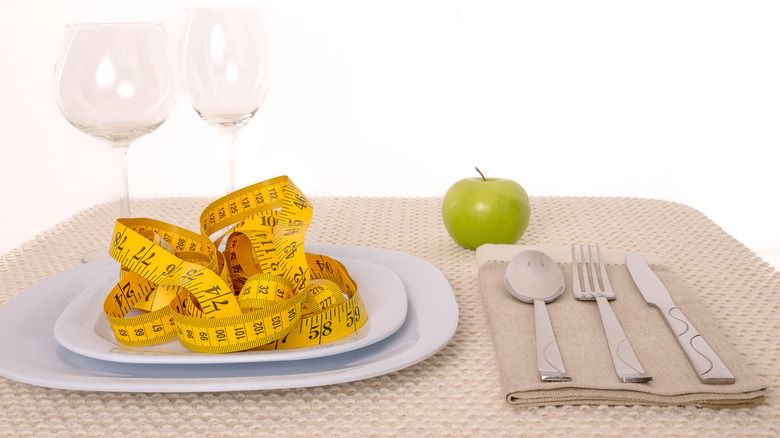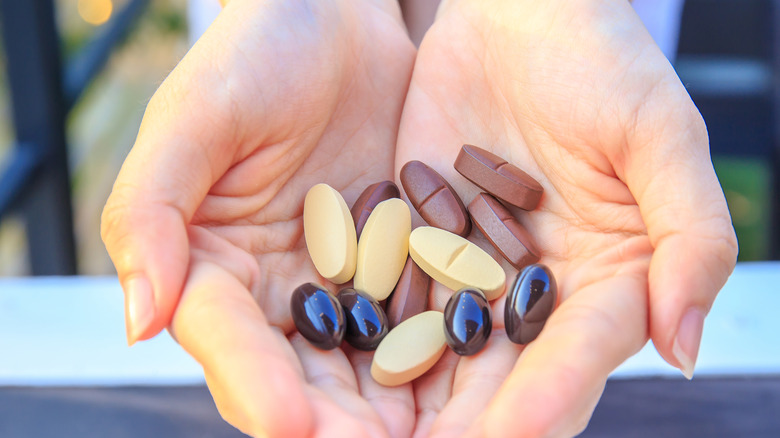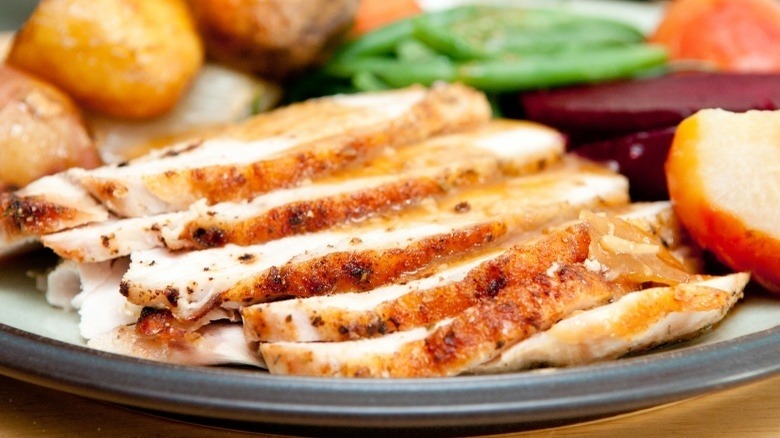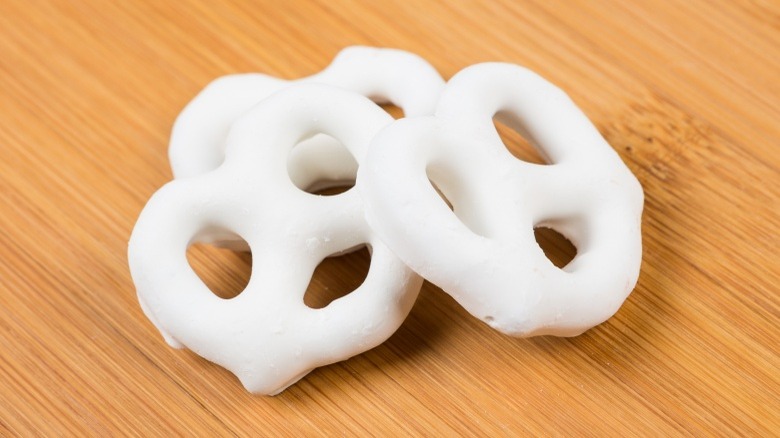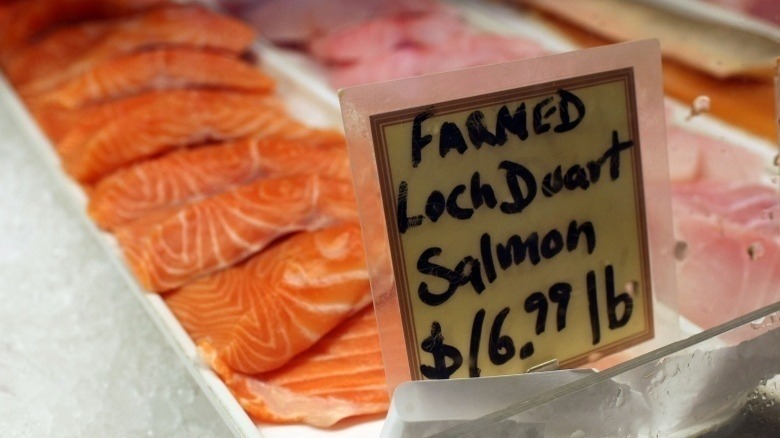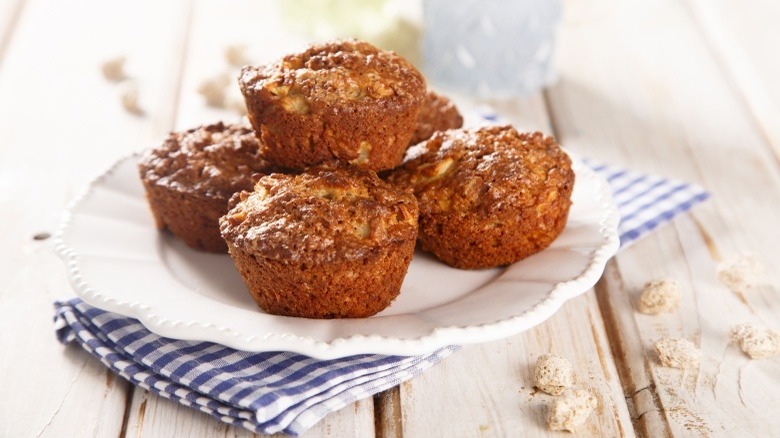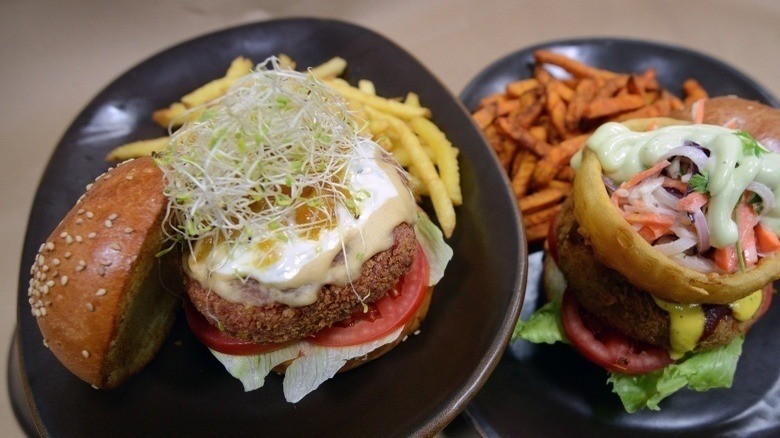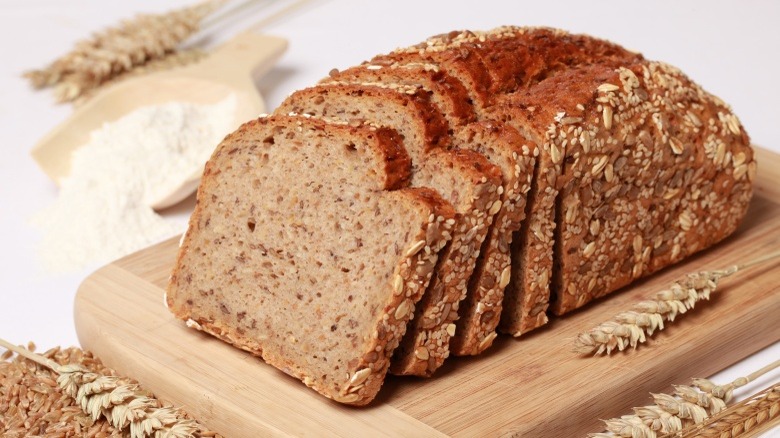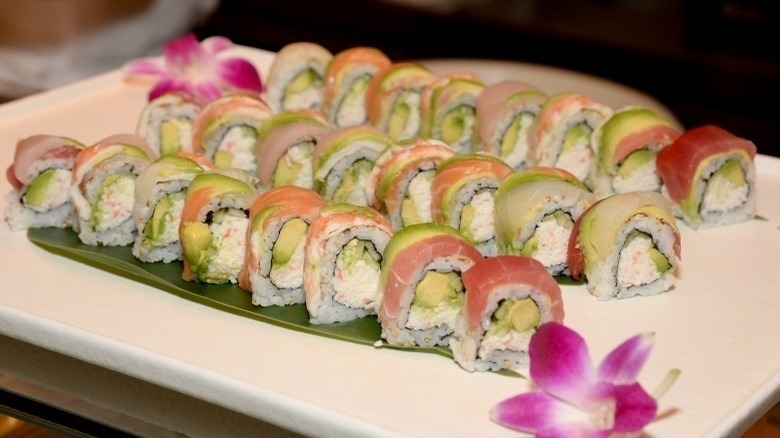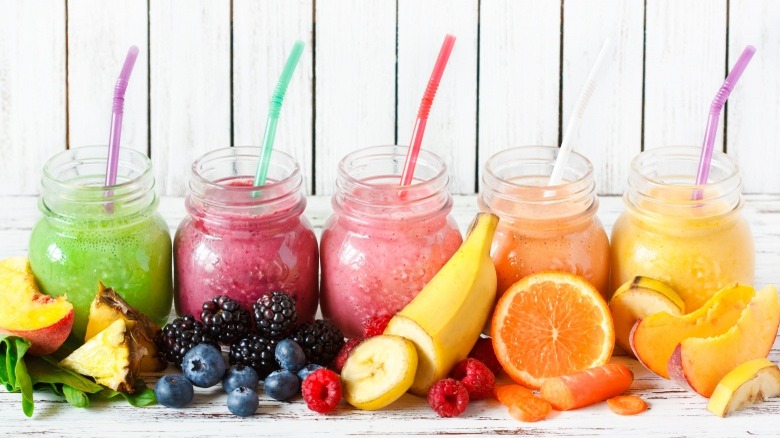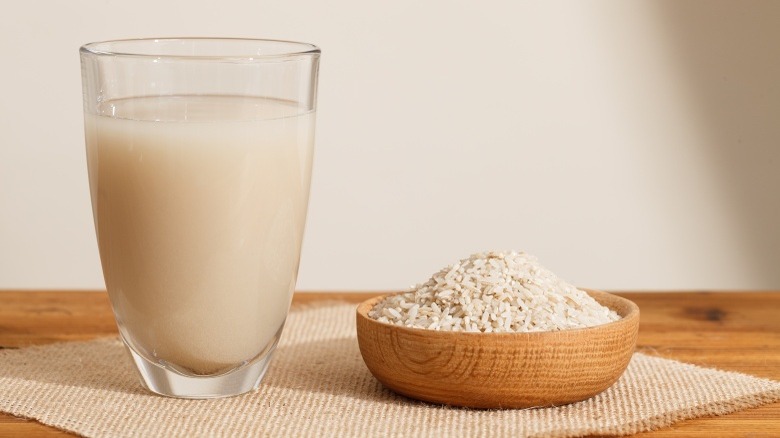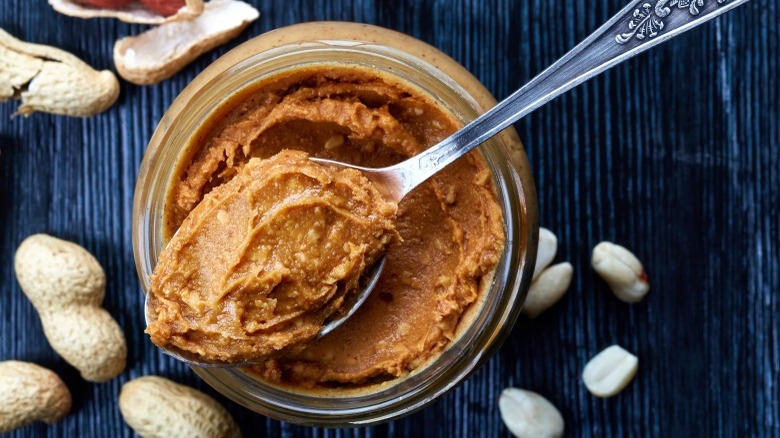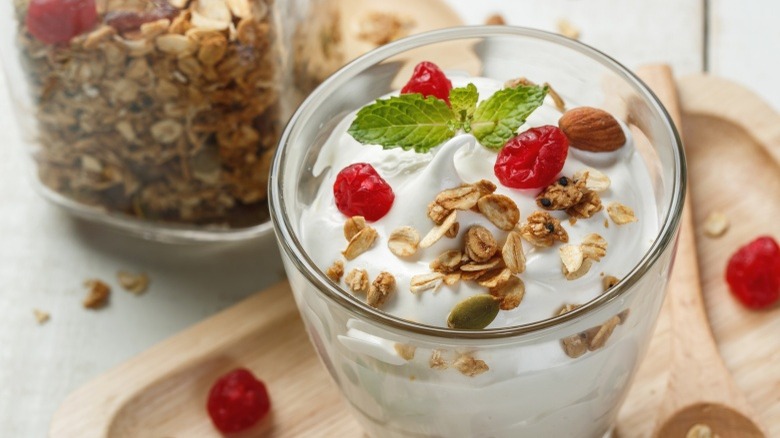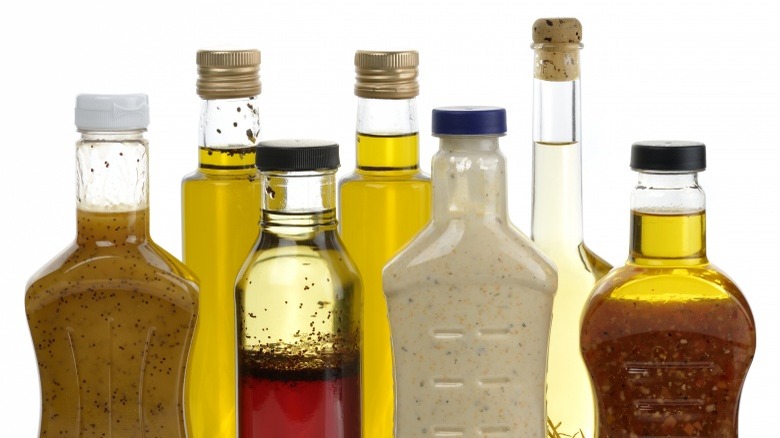Unhealthy Foods Most People Think Are Healthy
Trying to be healthy can be overwhelming, if not outright maddening. There's a ton of conflicting information out there, and recommendations seem to change faster than Usain Bolt can run 100 meters. Every week seems to bring new research claiming that what was considered to be bad for us is actually good — and that what was considered good is, in fact, not good at all.
It can be crazy-making, and for those of us who aren't professional nutritionists, it's hard to get a good sense of what's genuinely healthy, what's just hype, and what we should avoid. Luckily, there are some excellent resources and research are out there to help all of us — in the words of Jamie Lee Curtis' character in Freaky Friday — make good choices.
100% fruit juice
When health mavens began extolling the virtues of freshly-pressed juice, lots of people began jumping on the juicing bandwagon. However, according to an article published in The Washington Post that was written by three nutrition experts, "the truth is that fruit juice, even if is freshly pressed, 100 percent juice, is little more than sugar water." This is particularly frustrating when, as The Washington Post notes, "we are inundated with the message that juice is healthy."
How does this happen, when whole fruit is healthy on its own? The authors of the article explain that by stripping fruits of their skin, connective membranes, and seeds, juicing also removes the fiber that helps slow absorption of the naturally-occurring sugars in whole fruit. This leads to insulin spikes, which can eventually lead to Type 2 diabetes.
Adding to which, fruit juice can be high in calories — and drinking your calories, as opposed to eating them, tends to keep your stomach from sending the "Hey, I'm full!" signal to your brain. This leads to overeating, which can contribute to weight gain. So, how can you drink juice and stay healthy? According to WebMD, it's important to emphasize vegetables in your juice blends. This helps limit the calories and sugar in the juice. An even better alternative is to skip the juice and go for a smoothie — you can add protein and almond milk, and blend full fruits and veggies so you'll consume the pulp that was removed during the juicing process.
Microwave popcorn
Popcorn is a fabulous low-calorie, high-fiber, healthy snack — unless it comes from the microwave. For everyone who relies on a bag of microwave popcorn to get them through the 2 p.m. slump at work: I feel your pain.
In May 2015, a group of environmental scientists released The Madrid Statement — published in the journal Environmental Health Perspectives with the support of the National Institutes of Health — expressing their concerns about a group of substances known as perfluorinated chemicals (PFCs, also called PFSAs). PFCs, which are "man-made and found everywhere," according to The Madrid Statement, are also highly toxic and degrade very slowly.
Used to make products waterproof and greaseproof, the inside of microwave popcorn bags are also usually coated with PFCs. As a result, according to an article published in Today Healthy Living, the environmental advocacy group EWG suggests it's best to "pop popcorn the old-fashioned way, on the stovetop."
Diet sodas and artificial sweeteners
For many people, trying to lose weight often involves switching from regular soda to its zero-calorie, diet version. Sadly for those of us who like Diet Coke, this isn't such a great idea: according to a study published in the Yale Journal of Biology and Medicine (YJBM), artificial sweeteners in diet sodas can be problematic. "Intuitively, people choose non-caloric artificial sweeteners over sugar to lose or maintain weight," notes the YJBM. "Whether due to a successful marketing effort on the part of the diet beverage industry or not, the weight-conscious public often consider artificial sweeteners 'health food.'"
However, evidence is starting to show that artificial sweeteners may be correlated with weight gain and obesity in both children and adults. In fact, according to a meta analysis of research published in the Canadian Medical Association Journal, consumption of artificial sweeteners was associated with an increase in health indicators like waist circumference, obesity, hypertension, Type 2 diabetes, and cardiovascular disease.
As the YJBM notes, research suggests that this is because artificial sweeteners don't activate the brain's food reward pathways — the processes that help us feel satisfied after eating something sweet — the way natural sweeteners do. This can lead to increased appetite and sugar cravings, and you can see where this goes: straight to the ice-cream sandwiches. So, while consuming a lot of sugar isn't a great idea, it's best to cut out the diet foods and rely on natural sweeteners (like honey and maple syrup) in smaller amounts.
Sports drinks
For many of us who grew up in the '80s and '90s, the go-to recovery drink after every after school sports practice, and during every game, was some sort of sports drink like Gatorade or Powerade. It turns out that this wasn't such a grand plan after all: according to a report published by the University of California at Berkeley's Atkins Center for Weight and Health, even though sports drinks are marketed as ideal sources of rehydration that are "health and strength enhancing," they don't live up to the hype.
Not only do they fall short of marketing promises, but they can actually be detrimental to people's health. As the report notes, "These beverages are often fortified with added nutrients that are advertised as providing health benefits.... However, the sugar content and potential adverse effects of some additives outweigh any potential benefit those ingredients provide, especially among youth."
Even though sports drinks are meant to be consumed by athletes exercising strenuously for over an hour, it turns out that most of the people drinking them "are — more than anything — drawn to the marketing of these products, who have been convinced they need to replace their electrolytes," Harold Goldstein, the executive director of the California Center for Public Health Advocacy, told KQED News. So if you go for a long, summertime run outside, then by all means, fuel up on Gatorade — but for anything less than prolonged exertion with intense sweating, stick to water.
Soy protien
Soy has become a controversial topic in the last few years, with some people demonizing it and others saying it's healthy. According to Shape magazine, the evidence is mixed: "for every health benefit of the complete plant-based protein source, you'll also hear of a potential detrimental effect... however, because soy products come in such a wide variety — whole soy, fermented soy, soy protein isolate, and others — confusion continues to ensue."
While whole soy (such as tofu) and fermented soy (such as miso), are generally believed to be healthy, soy protein isolate seems to be the biggest offender. A heavily processed derivative of defatted soy flour, soy protein isolate is a popular way to add protein to, or improve the texture of, many pre-made foods, and it shows up in a lot of unexpected places.
Because of this, most people are probably consuming a lot of soy without even knowing it — and clinical nutritionist Sara Vance told Refinery29 that one downside of heavy soy consumption is possible mineral deficiencies. "Soy products are very high in phytic acid, which can interfere with mineral absorption.... Whereas soaking and sprouting other grains and legumes can remove the phytic acid, that does not work with soy, and the only way to neutralize the phytic acid in soy is to ferment it," she said.
Nutrition bars
For people who are constantly on the go, nutrition bars can offer a quick, convenient, and easily portable source of calories and nutrition (because nothing good comes from being hangry in a meeting). However, according to WebMD, "not all bars are created equal."
Registered Dietitian Dawn Jackson, spokeswoman for the American Dietetic Association, agrees with this idea, telling WebMD that "some of the bars have as much sugar and as much saturated fat as a candy bar. So use them in moderation." It's also important not to let bars push whole foods out of your diet or rely on them at the exclusion of anything else, since no one food can give you the full array of vitamins and nutrients that your body needs.
Another key to healthy nutrition bars is to look carefully at what's in each one, since ingredients can include things like the soy protein isolate discussed above, lots of sweeteners, or fillers instead of fiber. And, as WebMD also notes, "some are nothing more than glorified candy bars." When reading the label, be sure to look at the back of the packaging (this is where the actual information is, as opposed to the marketing hype trying to make you believe it'll turn you into Gal Gadot), and look for something that has 220-230 calories, less than five grams of fat, three to five grams of fiber, 10-15 grams of protein, and as few sweeteners as possible.
Low-fat and fat-free foods
Among the various foibles of decades past — including gems like mullets, polyester leisure suits, and eyebrows plucked within a millimeter of their existence — lies the idea that low-fat and fat-free foods are super healthy. As it turns out, the nutrition mantra of the '90s was totally wrong.
According to CBS News, a Tufts University study showed that "people who consumed full-fat dairy products had as much as a 46 percent lower risk of developing diabetes" compared to people who ate low-fat and non-fat dairy. A second study, which tracked both diet and the incidence of mortality and major cardiac events among people in 18 countries, found that "high carbohydrate intake was associated with higher risk of total mortality, whereas total fat and individual types of fat were related to lower total mortality."
So why are reduced and non-fat products on the outs? It largely boils down to taste (pun intended). According to WebMD, low-fat and fat-free foods often lose flavor when the fat is extracted. So, to compensate for the lack of flavor, "food makers tend to pour other ingredients — especially sugar, flour, thickeners, and salt — into the products. That can add calories." In fact, research has shown that higher fat foods tend to be more satiating than lower fat foods and can lead to greater weight loss than high-carb/low-fat diets. So, while it doesn't give us all license to slather everything in butter, we definitely shouldn't fear fat.
Multivitamins
Many of us grew up thinking that more is better when it comes to vitamins — think of those ultra-mega-super-vitamins you see in supplement stores — but recent evidence suggests that this isn't the case. Dr. Paul Offit, a researcher at the Children's Hospital of Philadelphia, told NPR that a 1994 law exempts dietary supplements and vitamins from tighter regulation and oversight by the Federal Drug Administration (FDA). Offit notes that this means supplements can make claims about health benefits that they may not have.
Worse, though, is that recent data indicates that getting too much beta-carotene, vitamin E, and vitamin A can be detrimental to your health, particularly in older age. So what's the best course of action? The American Heart Association recommendations are straightforward: eat healthy foods. While supplements can help, "the key to vitamin and mineral success is eating a balanced diet." This is because "foods provide many bioactive compounds and dietary fiber that typically aren't found in supplements."
If you're eating a healthy diet and still deficient (the most common deficiencies for women include iron, calcium, and vitamin D), then supplementation is okay — but experts insist that we try to get our vitamins and minerals from food as much as possible.
Clean eating
The upshot of most of this research is that it's best to rely on whole, unprocessed foods. Because of this, "clean eating" — the all-encompassing term for trying to eat more unrefined, whole foods — has become enormously popular in recent years. An article in The Guardian notes that a justifiable anxiety about food is one of the primary forces driving the clean eating trend: we're "living in an environment where ordinary food, which should be something reliable and sustaining, has come to feel noxious." Seeing the slew of afflictions associated with post-WWII nutrition, such as heart disease and diabetes, many people became "understandably scared of the modern food supply and what it was doing to our bodies."
However, clean eating becomes a problem comes when it morphs into an obsession. Orthorexia, which the American Psychiatric Association describes as "a term used to describe a dietary pattern in which an individual restricts intake to include only 'healthy' foods, such as vegetables or organic foods, but in doing so develops significant problems, such as an obsession with food and severe weight loss," is increasingly prevalent in developed countries.
While orthorexia usually starts out as a well-intentioned effort to eat more healthy foods, the infusion of moral value into foods — such as clean or dirty — can lead to an obsession with only eating healthy, "virtuous" foods. So, while clean eating can be useful, red flags include "a restrictive diet, ritualized patterns of eating, and rigid avoidance of foods believed to be unhealthy or impure."
Turkey
If you don't buy organic turkey and just opt for what is in the grocery store or on the menu, you may be getting a healthy dose of arsenic. It's hard to believe that something lethal would be put in poultry, but it's actually quite handy at preventing parasitic infections. The National Chicken Council has stopped using any arsenic-based drugs because of bad press regarding all the chicken Americans consume. However, the National Turkey Federation is under different guidelines and still gives turkeys the old drug regime during the first few weeks of their lives and in summer months. It's not in all turkey, as it's banned in the European Union, but it is still in American turkey meat.
Arsenic just sounds bad, but to recap, it can cause cancer or death when exposure is too high. Prolonged ingestion can also hurt many body parts, including the skin, gut, blood vessels, immune system, lungs, heart, urinary system, reproductive organs, and the nervous system.
Yogurt-covered pretzels
Low-fat pretzels dipped in vanilla yogurt can appear to be a delicious and healthy snack at first glance, but look again. First, they cannot possibly just simply be dipped in yogurt, because these snacks sit on the grocery store shelves, as opposed to being in the refrigerated sections. "While these coatings may be called 'yogurt,' they are really a kind of 'frosting' of which yogurt is an ingredient," David Katz, MD, director of the Yale University Prevention Research Center explained to Time. "Having the name 'yogurt' in the mix is supposed to make it all okay. It does not."
And it's not just the fake yogurt that makes this snack a bad choice. Pretzels themselves are no angels either. While pretzels are pretty low in calories, they have usually been stripped of any nutrients. They can also be high in sodium. If you crave a crunchy snack, try fresh vegetables dipped in hummus or apple slices with a natural nut butter.
Can't get enough of this sneakily unhealthy treat? Try whipping up a batch yourself to add real yogurt and ditch the sugary imposter. That's what Cleveland Clinic dietician Jennifer Willoughby does. "Choose a plain or vanilla yogurt to dip fruit or nuts in, and then freeze for a sweet treat with significantly less added sugar and more nutritional benefit," she recommended to Time.
Farmed salmon
Salmon is constantly under scrutiny, yet has always been heralded as a superfood filled with healthy protein. Consumption of this beautiful fish is in high demand while the wild-caught supply is decreasing, giving way to a booming farming industry. To keep up with the demand, salmon farmers devise many ways to raise the fish, including feeding them other threatened fish or poor-grade fish food and keeping them in confined spaces. The result has been fish loaded with omega-6 fatty acids, which increase inflammation, blood clotting, and cell proliferation, as opposed to the desired omega-3s, which do the opposite. A half-fillet of wild-caught salmon has an estimated 341 milligrams of omega-6, while farm-raised ones contain a whopping 1,944 milligrams. If that isn't bad enough, farmed salmon is often dyed pink to look healthier and has thus tested to be higher in PCBs, a cancer-causing industrial chemical.
The healthiest option will always be wild-caught, and there are some farms out there making great improvements. With a little research, you may find a sustainable, healthier option. Until then, how do you feel about sardines?
Canned soups
Soup isn't just for cold days. It's a staple for many diets and often used to lose weight or maintain a healthy diet. A satiating bowl is loaded with great ingredients, complements many meals, and is offered at a low cost. So how can it be bad? Simple: many popular soup brands, like Campbell's and Maruchan Ramen Noodes, are loaded with monosodium glutamate (MSG), a common additive that enhances flavor and increases appetite, but is consequently known to cause headaches, flushing, sweating, numbness, tingling or burning in the face, heart palpitations, chest pain, nausea, and weakness in many individuals. The way around this is, of course to make homemade soup, but if convenience is what you're after, look for brands that identify themselves as not using the additive. If you're at a restaurant, ask your server what they use.
Bran muffins
Imagine this. It's about 10 a.m. at work, and you are fading fast. Maybe it was that late night Gilmore Girls binge or the fact that you pressed the snooze button five times, but you are dozing at your desk. You walk to the coffee shop for a little pick-me-up and peruse the bakery while the barista makes your latte. You've been on a health kick lately, so you confidently pass on the croissants and cookies, opting for a healthy bran muffin. Unfortunately, you could have just enjoyed the cookie since the muffin wasn't much better. "Depending on the size, a bran muffin can have more calories and sugar than a doughnut," nutritionist Joan Salge Blake, RD, LDN, author of Nutrition & You, explained to Woman's Day.
Registered dietician Kristin Kirkpatrick advocates for always checking nutritional labels, even when you think the food is healthy. "Most commercially sold bran muffins contain about 800 calories of pure sugar and fat, well above the calorie count of many traditional cake doughnuts," she shared. "While I'm definitely not advocating consumption of doughnuts for breakfast, I am pointing out that sometimes what we think is 'healthy' is actually far worse for us than foods we know are NOT healthy." Never assume that any packaged food is healthy. Your best bet is to make your own or check nutrition labels first.
Soy veggie burgers
At first, this one doesn't make sense. Doesn't soy veggie just sound healthy? After all, when you flip the box over and read the ingredients, you'll find stuff like soy protein. But as it turns out, soy protein is actually made from genetically modified soybeans, often grown in China and then processed by immersing the soybeans with hexane. Hexane is a petroleum-based neurotoxic solvent, produced as a byproduct of gasoline refining, and is also a hazardous air pollutant. Basically, there's nothing about hexane that can be considered redeeming. Instead, opt for veggie burger varieties or go crazy and eat the old standby ... a burger made of meat! Red meat skeeviness aside, at least ground cow doesn't contain any literally explosive ingredients.
Multigrain bread
Going out for brunch is one of my favorite ways to spend a lazy Saturday morning. I love sitting there talking with my family, sipping my coffee, and I always order the same thing. I'll smugly order a veggie omelette with multigrain toast, knowing that I'm just so much healthier than the table next to us ordering white bread. Well, it turns out I'm not quite as healthy as I'd like to think.
The nutrition experts at Cooking Light shares that labels such as "multigrain" and "wheat" breads don't equate to a healthy choice. Just like white bread, its multigrain cousin can also contain refined grains, which have been stripped of their fiber and nutrients. Because these refined grains won't keep us full, we could end up craving our next meal after only an hour or so. Rather than looking at the name of the bread, check the nutrition facts and make sure "whole grains" are first on the ingredient list.
Sushi
Sushi used to be a hard sell for people. Raw fish? No, thank you. Fast-forward to a nice California roll or a spicy tuna roll, and all is forgiven. Sushi can be satisfying, fresh, and very healthy ... seemingly. Remember, sushi's made mostly of rice and very little fresh fish or vegetables, making it a carbohydrate explosion. A normal California roll is like eating four slices of bread, and the spicy tuna roll is like adding another three slices, with lots of mayonnaise to boot. Another issue with the rice is that it's almost never organic. Like many grains, it carries unwanted chemicals, including our old buddy arsenic. Add the fish, which can be farmed, endangered, and seeped in mercury, and rice-heavy sushi is basically no healthier than a Snickers bar.
The best option when chopsticks are in hand is to order sparingly, conscientiously, and with substitutions, like using cucumbers to wrap the fish instead of rice, and nixing the mayo entirely. Also, add some nutritious side salads, edamame, and protein-rich appetizers, and you'll actually be eating something healthy.
Pre-made smoothies
Blending up some fresh fruit, spinach and water or nut milk is a quick and healthy way to start the day. I love preparing a smoothie at night, then having my breakfast ready to go as I dash out the door every morning. Making your own smoothies can help you fit in those necessary daily servings of fruits and vegetables. However, not all smoothies are created equal. Many smoothies you buy at restaurants are just one big sugar bomb, and you might even be better off with a milkshake. For example, the Matcha Green Tea Smoothie at Jamba Juice has a whopping 57 grams of sugar — and that's just in a size small!
Registered dietician Kristin Kirkpatrick agrees. "That premade or store-bought smoothie you think is so healthy may in fact have more calories than a cheeseburger," she shared. "Smoothies can have as much as 650 to 1000 calories in them due to the extreme portions of fruit, vegetables, and, oftentimes, added simple sugars and syrups." As with any type of food, it's easy to overdo it when it comes to smoothies. If you can't get enough of that icy breakfast treat, try making your own at home or buying the smallest size.
Rice milk
Alternative milks usually sound healthier than traditional cow's milk. If you take a look at the dairy-free options on the grocery store shelves, you'll see milks made from almonds, cashews, soybeans, coconuts, and rice. These alternative milks are also trendy. Who doesn't like to sound cool and health conscious as you order your almond milk latte at the coffee house? The issue is that these milks aren't necessarily healthier than cow's milk — particularly rice milk.
Bethany Thayer, RD, director of the Center for Health Promotion and Disease Prevention at the Henry Ford Health System in Detroit, told Prevention that unless it is fortified, rice milk is "simply fluid from rice that's naturally high in carbohydrates and low in protein and calcium." She explained that if you tolerate dairy well, it's healthier to opt for organic skim milk than rice milk. At least skim milk contains loads of essential nutrients like calcium, potassium, vitamin A, and magnesium.
Nut butters
While nuts can be high in fat, it's healthy fat and they're also full of protein. Just a small amount can fill you up and keep you going for hours. Spreading some nut butter on your whole grain bread or fruit slices, whether it's from peanuts, almonds, or cashews is a great way to add some protein to your breakfast or snack. Registered dietician Kristin Kirkpatrick also loves adding nuts to her diet. "They've been shown to help boost heart health and keep weight down," she shared.
The nuts are not the problem when it comes to nut butters. It's the added sugar, artificial sweeteners, and trans fats. "When it comes to nut butters, stick with options that have one to two ingredients; for example, peanuts or peanuts and salt," recommends Kirkpatrick. "Once you go beyond that, your health food has just become unhealthy."
Fat-free yogurt
Fat-free and low-sugar yogurts and ice creams are usually displayed all over the grocery store shelves. Enjoy flavors like orange creamsicle and red velvet cake without the guilt! But doesn't it seem weird that companies can achieve those sweet flavors with no sugar or fat? What's going on there?
Personal trainer Jennifer Cohen isn't buying it. "Say it with me: fat-free foods are NOT health foods! I always say fat doesn't make you fat, sugar makes you fat," she explained to Forbes. "Most flavored yogurts pack 15 grams of sugar in 6 oz., and yes, even if they're flavored with fruit, they're not healthy." If you're craving your afternoon sweet treat, ditch the fake flavors and enjoy real Greek yogurt with some berries and a drizzle of honey. Not only is it not hiding tons of artificial sweeteners, but the protein in Greek yogurt will keep you full until dinner.
And if you're used to a little guilt-free ice cream after dinner, we have some bad news for you. When it comes to no-sugar added ice cream, if it sounds too good to be true, it is. "I never buy no-sugar-added or light ice creams. The no-sugar-added types may have up to 18 additional ingredients, including artificial sweeteners that can even produce a laxative effect," nutritionist Maggie Michalczyk, RD shared with CNN. "Go for the real thing — not only will you be more satisfied with less, you'll be doing your health and digestive system a favor."
Store-bought salad dressing
You can't get much healthier than a nice light salad for lunch. You can feel good about yourself as you shake up your adorable mason jar salad, knowing that you've totally earned that afterwork happy hour tonight. While it's great to load up on healthy veggies and nuts in your salad, make sure your salad dressing isn't sabotaging your healthy efforts.
When picking out a salad dressing, it's important to (say it with me now), read the label! Even if your salad dressing looks like a nice, light oil-based dressing, you just never know what's lurking in there. "They [salad dressings] can contain highly processed oils or partially hydrogenated oils, added sugar, high fructose corn syrup, artificial sweeteners, and artificial colors," Megan Roosevelt, RD, founder and host of The Healthy Grocery Girl Cooking Show on YouTube told CNN, "Choose one with ingredients you can pronounce." Roosevelt opts for making her own dressing with olive oil, apple cider vinegar, lemon juice, maple syrup, and spices.
Moderation over perfection
Living and eating well in the modern world can seem overwhelming. You had to be across town five minutes ago, your boss needs that report now, and you haven't eaten in hours — but the only thing you have on hand is a granola bar. This is when it's all too easy to start worrying about the contents of that granola bar and wondering if you're harming your health by eating it. But the reality is, moderation is key.
Yes, the ideal is to eat whole, unprocessed foods, but life doesn't always allow for us to reach that ideal state of being. If you don't always hit your five servings per day of fruits and veggies, that's okay. And it's also okay if you sometimes need a protein bar, bag of microwave popcorn, or Diet Coke to get you through the day.
Healthy eating isn't an all-or-nothing scenario. Just as there are times when getting something done is better than doing it perfectly, you also don't have to eat "perfectly" in order to be healthy. Do the best with what you have — your individual circumstances, resources, and abilities — and know that this is healthy in and of itself.

